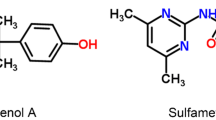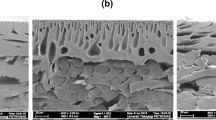Abstract
Hydrophobic acid organic matter (HpoA) extracted from treated effluent has been known to improve the rejection of steroid hormone estrone by reverse osmosis (RO) and nanofiltration (NF) membranes. In this study, the effects of solution chemistry (solution pH and ionic strength) on the estrone rejection by NF membrane with the presence of HpoA were systematically investigated. Crossflow nanofiltration experiments show that the presence of HpoA significantly improved estrone rejection at all pH and ionic strength levels investigated. It is consistently shown that the “enhancement effect” of HpoA on estrone rejection at neutral and alkaline pH is attributed to the binding of estrone by HpoA macromolecules via hydrogen bonding between phenolic functional groups in feed solutions, which leads to an increase in molecular weight and appearance of negative charge. The membrane exhibited the best performance in terms of estrone rejection at pH 10.4 (compared to pH 4 and pH 7) as a result of strengthening the electrostatic repulsion between estrone and membrane with the presence of HpoA. At neutral pH level, the ability of HpoA macromolecules to promote estrone rejection became stronger with increasing ionic strength due to their more extended conformation, which created more chances for the association between estrone and HpoA. The important conclusion of this study is that increasing solution pH and salinity can greatly intensify the “enhancement effect” of HpoA. These results can be important for NF application in direct/indirect potable water reuse.
Similar content being viewed by others
References
Baker V A. Endocrine disrupters—testing strategies to assess human hazard. Toxicology In Vitro, 2001, 15(4–5): 413–419
Tim Z. In vitro bioassays for assessing estrogenic substances. Environmental Science & Technology, 1997, 31(3): 613–623
Iguchi T, Watanabe H, Katsu Y. Developmental effects of estrogenic agents on mice, fish, and frogs: a mini-review. Hormones and Behavior, 2001, 40(2): 248–251
Desbrow C, Routledge E J, Brighty G C, Sumpter J P, Waldock M. Identification of estrogenic chemicals in STW effluent. 1. Chemical fractionation and in vitro biological screening. Environmental Science & Technology, 1998, 32(11): 1549–1558
Ternes T A, Stumpf M, Mueller J, Haberer K, Wilken R D, Servos M. Behavior and occurrence of estrogens in municipal sewage treatment plants—I. Investigations in Germany, Canada and Brazil. Science of the Total Environment, 1999, 225(1–2): 81–90
Johnson A C, Sumpter J P. Removal of endocrine-disrupting chemicals in activated sludge treatment works. Environmental Science & Technology, 2001, 35(24): 4697–4703
Baronti C, Curini R, D’Ascenzo G, Corcia A D, Gentili A, Samperi R. Monitoring natural and synthetic estrogens at activated sludge sewage treatment plants and in a receiving river water. Environmental Science & Technology, 2000, 34(24): 5059–5066
Williams R J, Johnson A C, Smith J J L, Kanda R. Steroid estrogens profiles along river stretches arising from sewage treatment works discharges. Environmental Science & Technology, 2003, 37(9): 1744–1750
Nghiem L D, Schäfer A I, Elimelech M. Pharmaceutical retention mechanisms by nanofiltration membranes. Environmental Science & Technology, 2005, 39(19): 7698–7705
Schäfer A I, Nghiem L D, Waite T D. Removal of the natural hormone estrone from aqueous solutions using nanofiltration and reverse osmosis. Environmental Science & Technology, 2003, 37(1): 182–188
Jin X, Hu J, Ong S L. Removal of natural hormone estrone from secondary effluents using nanofiltration and reverse osmosis. Water Research, 2010, 44(2): 638–648
Nghiem L D, Schäfer A I, Elimelech M. Removal of natural hormones by nanofiltration membranes: measurement, modeling, and mechanisms. Environmental Science & Technology, 2004, 38(6): 1888–1896
Jin X, Hu J, Ong S L. Influence of dissolved organic matter on estrone removal by NF membranes and the role of their structures. Water Research, 2007, 41(14): 3077–3088
Bellona C, Drewes J E, Xu P, Amy G. Factors affecting the rejection of organic solutes during NF/RO treatment—A literature review. Water Research, 2004, 38(12): 2795–2809
Childress A E, Elimelech M. Effect of solution chemistry on the surface charge of polymeric reverse osmosis and nanofiltration membranes. Journal of Membrane Science, 1996, 119(2): 253–268
Childress A E, Elimelech M. Relating nanofiltration membrane performance to membrane charge (electrokinetic) characteristics. Environmental Science & Technology, 2000, 34(17): 3710–3716
Jin X. Rejection of steroid hormone estrone by NF/RO membranes. Dissertation for the Doctoral Degree. Singapore: National University of Singapore, 2007
Tang C, Kwon Y N, Leckie J O. Fouling of reverse osmosis and nanofiltration membranes by humic acid—Effects of solution composition and hydrodynamic conditions. Journal of Membrane Science, 2007, 290(1–2): 86–94
Ghosh K, Schnitzer M. Macromolecular structures of humic substances. Soil Science, 1980, 129(5): 266–276
Hu J Y, Jin X, Ong S L. Rejection of estrone by nanofiltration: Influence of solution chemistry. Journal of Membrane Science, 2007, 302(1–2): 188–196
Illés E, Tombácz E. The role of variable surface charge and surface complexation in the adsorption of humic acid on magnetite. Colloids and Surface A. Physicochemical and Engineering Aspects, 2004, 230(1–3): 99–109
Tombácz E, Libor Z, Illés E, Majzik A, Klumpp E. The role of reactive surface sites and complexation by humic acids in the interaction of clay mineral and iron oxide particles. Organic Geochemistry, 2004, 35(3): 257–267
Ephraim J H, Pettersson C, Allard B. Correlations between acidity and molecular size distributions of an aquatic fulvic acid. Environment International, 1996, 22(5): 475–483
Author information
Authors and Affiliations
Corresponding author
Rights and permissions
About this article
Cite this article
Jin, X., Hu, J. Role of water chemistry on estrone removal by nanofiltration with the presence of hydrophobic acids. Front. Environ. Sci. Eng. 9, 164–170 (2015). https://doi.org/10.1007/s11783-014-0747-9
Received:
Accepted:
Published:
Issue Date:
DOI: https://doi.org/10.1007/s11783-014-0747-9




